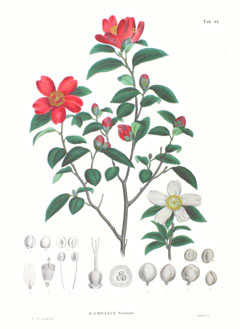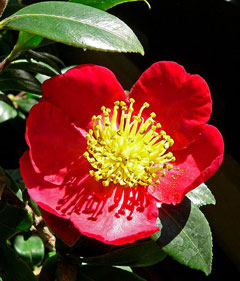 |
|
http://commons.wikimedia.org/wiki/File:Camellia_sasanqua_SZ83.png |
 |
| http://commons.wikimedia.org/wiki/User:Stan_Shebs |
Translate this page:
Summary
Bloom Color: Lavender, Orange, Pink, Red, White, Yellow.
Main Bloom Time: Early spring, Early winter, Late fall, Late winter, Mid fall, Mid spring, Mid winter. Form: Oval.
Physical Characteristics

 Camellia sasanqua is an evergreen Shrub growing to 3 m (9ft) by 1.5 m (5ft) at a slow rate.
Camellia sasanqua is an evergreen Shrub growing to 3 m (9ft) by 1.5 m (5ft) at a slow rate.
See above for USDA hardiness. It is hardy to UK zone 8. It is in leaf all year, in flower from October to April. The species is hermaphrodite (has both male and female organs) and is pollinated by Bees.
Suitable for: light (sandy) and medium (loamy) soils and prefers well-drained soil. Suitable pH: mildly acid and neutral soils and can grow in very acid soils.
It can grow in semi-shade (light woodland) or no shade. It prefers moist soil.
UK Hardiness Map
US Hardiness Map
Synonyms
Thea sasanqua.
Plant Habitats
Woodland Garden Sunny Edge; Dappled Shade; Shady Edge; Hedge;
Edible Uses
Edible Parts: Oil Oil
Edible Uses: Oil Oil Tea
The oil obtained from the seed is edible if it is refined[46, 105, 142, 183]. It is said to be equal in quality to olive oil[2]. The leaves are mixed with tea to give it a pleasant aroma[2, 183].
References More on Edible Uses
Medicinal Uses
Plants For A Future can not take any responsibility for any adverse effects from the use of plants. Always seek advice from a professional before using a plant medicinally.
Demulcent Expectorant
Demulcent, expectorant[178].
References More on Medicinal Uses
The Bookshop: Edible Plant Books
Our Latest books on Perennial Plants For Food Forests and Permaculture Gardens in paperback or digital formats.

Edible Tropical Plants
Food Forest Plants for Hotter Conditions: 250+ Plants For Tropical Food Forests & Permaculture Gardens.
More

Edible Temperate Plants
Plants for Your Food Forest: 500 Plants for Temperate Food Forests & Permaculture Gardens.
More

More Books
PFAF have eight books available in paperback and digital formats. Browse the shop for more information.
Shop Now
Other Uses
Dye Hedge Hedge Oil Oil Soap
A non-drying oil is obtained from the seed - used as a hair-dressing and textile oil[46, 61, 171, 177]. A green dye is obtained from the pink or red petals[168]. A decoction of the plant (could this refer to the oil in the seed??) is used as a soap substitute for washing oily clothes[178]. Plants can be used as a hedge. The cultivar 'Onigoromo' has been especially mentioned for this purpose[188].
Special Uses
Espalier Hedge Hedge Scented Plants
References More on Other Uses
Cultivation details
Landscape Uses:
Border, Container, Espalier, Standard, Specimen. Prefers a woodland soil but thrives in a warm open well-drained loam if leafmould is added[1, 11, 200]. A calcifuge plant, preferring a pH between 5 and 7[11, 200]. Dislikes cold winds[11]. Prefers the partial shade of a light woodland[200], growing well in a woodland clearing[166]. Many cultivars tolerate full sun, in fact one report says that the species flowers better in a sunny position[182] and another that the plant prefers a hot sunny position[188]. Plants are hardy to about -10°c[184]. Another report says that this species is very cold hardy if it is sheltered from cold winds[11]. Prefers a wet summer and a cool but not very frosty dry winter[200]. Another report says that the plant requires hot summers if it is to do well[260]. Plants are not very self-compatible, self-fertilized flowers produce few seeds and these are of low viability[200]. A very ornamental plant[1], it is closely allied to C. oleifera[11]. The cultivar 'Narumi-gata' (which is sometimes mistakenly called C. oleifera) is a very reliable shrub in Britain[11]. Plants resent root disturbance and are best planted out into their final positions whilst still young. This species is cultivated in Asia for the oil in its seed, there are many named varieties mostly developed for their ornamental value[182]. The flowers have a delicate sweet perfume[245]. Special Features:Attractive foliage, Not North American native, Extended bloom season in Zones 9A and above, Fragrant flowers, Blooms are very showy.
References Carbon Farming Information and Carbon Sequestration Information
Temperature Converter
Type a value in the Celsius field to convert the value to Fahrenheit:
Fahrenheit:
The PFAF Bookshop
Plants For A Future have a number of books available in paperback and digital form. Book titles include Edible Plants, Edible Perennials, Edible Trees,Edible Shrubs, Woodland Gardening, and Temperate Food Forest Plants. Our new book is Food Forest Plants For Hotter Conditions (Tropical and Sub-Tropical).
Shop Now
Plant Propagation
Seed - can be sown as soon as it is ripe in a greenhouse[113]. Stored seed should be pre-soaked for 24 hours in warm water and the hard covering around the micropyle should be filed down to leave a thin covering[78, 113, 138]. It usually germinates in 1 - 3 months at 23°c[138]. Prick out the seedlings into individual pots when they are large enough to handle and grow them on in light shade in the greenhouse for at least their first winter. Plant them out into their permanent positions when they are more than 15cm tall and give them some protection from winter cold for their first year or three outdoors[K]. Cuttings of almost ripe wood, 10 - 15cm with a heel, August/September in a shaded frame. A high percentage take, but they are slow to root[78]. Cuttings of firm wood, 7 - 10cm with a heel, end of June in a frame[11, 78]. Keep in a cool greenhouse for the first year[11]. Leaf-bud cuttings, July/August in a frame.
Other Names
If available other names are mentioned here
Cha hua, Chamei, Kamelia sasangkua, Mei camellia, Perdu teh sasangkua, Sazanka, Shan cha, So, Tra-mai,
Native Range
TEMPERATE ASIA: Japan (Kyushu, Ryukyu Islands, Shikoku)
Weed Potential
Right plant wrong place. We are currently updating this section.
Please note that a plant may be invasive in one area but may not in your area so it's worth checking.
Conservation Status
IUCN Red List of Threatened Plants Status :

Growth: S = slow M = medium F = fast. Soil: L = light (sandy) M = medium H = heavy (clay). pH: A = acid N = neutral B = basic (alkaline). Shade: F = full shade S = semi-shade N = no shade. Moisture: D = dry M = Moist We = wet Wa = water.
Now available:
Food Forest Plants for Mediterranean Conditions
350+ Perennial Plants For Mediterranean and Drier Food Forests and Permaculture Gardens.
[Paperback and eBook]
This is the third in Plants For A Future's series of plant guides for food forests tailored to
specific climate zones. Following volumes on temperate and tropical ecosystems, this book focuses
on species suited to Mediterranean conditions—regions with hot, dry summers and cool, wet winters,
often facing the added challenge of climate change.
Read More
Expert comment
Author
Thunb.
Botanical References
1158200
Links / References
For a list of references used on this page please go here
Readers comment
| Add a comment |
|
If you have important information about this plant that may help other users please add a comment or link below. Only comments or links that are felt to be directly relevant to a plant will be included. If you think a comment/link or information contained on this page is inaccurate or misleading we would welcome your feedback at [email protected]. If you have questions about a plant please use the Forum on this website as we do not have the resources to answer questions ourselves.
* Please note: the comments by website users are not necessarily those held by PFAF and may give misleading or inaccurate information.
To leave a comment please Register or login here All comments need to be approved so will not appear immediately.
|
Subject : Camellia sasanqua
|
|
|
|